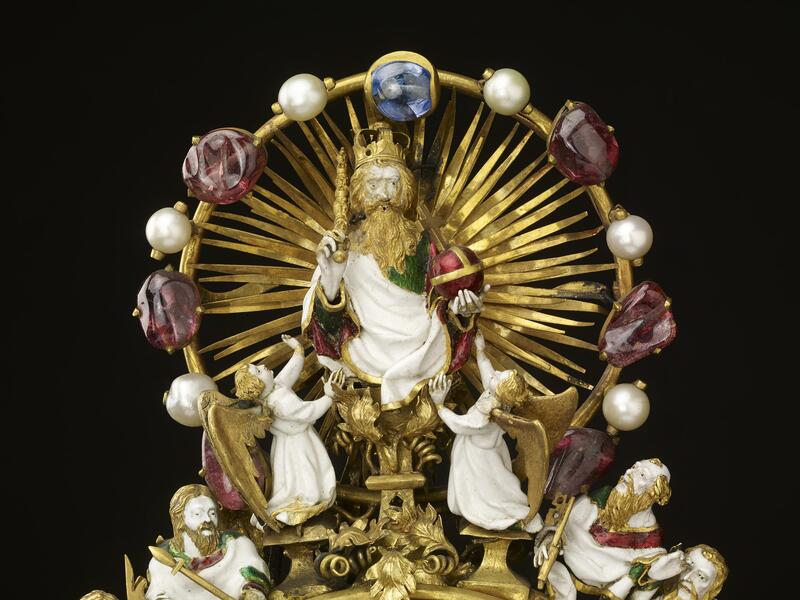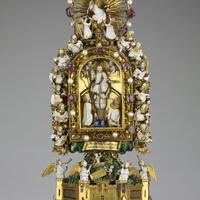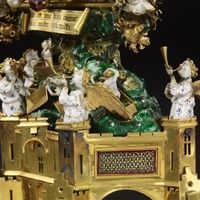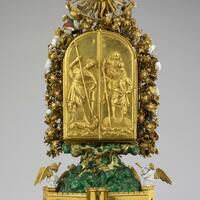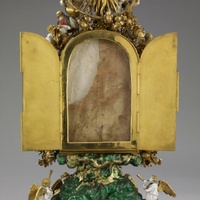Holy Thorn reliquary
Type:
Reliquaries
Date:
1390s
Location or Findspot (Modern-Day Country):
France
Medium:
Gold,
Enamel,
Rock crystal,
Gems,
Pearl
Dimensions:
30.5 × 15 × 7 cm
Description:
Red and blue enamel plaques on the base of this multimedia reliquary reveal that it was made for Jean, the duke of Berry, before 1397. Jean was the son, brother, and uncle of French kings of the Valois dynasty and a major patron of the arts. It held a single thorn from the crown of thorns worn by Christ at the Crucifixion, a precious relic housed since the 1240s at the Sainte-Chapelle in Paris. French kings awarded individual thorns as powerful gifts, however, and Jean de Berry owned at least six of them. He gave three to his palace chapel (and intended burial place) at Bourges, which was meant to compete with the Parisian Sainte-Chapelle. The Holy Thorn reliquary seems to be referenced (as "a thorn in a large gold jewel") in an inventory of Jean's possessions in 1401–3, but it does not appear in later inventories, so he probably gave it away before his death in 1416.
At the base of the reliquary is a golden city. Its turrets are topped by trumpeting angels who herald the resurrection of the dead, shown emerging from tiny sarcophagi in a green mound that represents Earth. Above them, a scroll in Latin says "This is a Thorn from the Crown of Our Lord Jesus Christ." Just above, in the central arched panel protected by rock crystal, is a Last Judgment or Second Coming scene: Christ displays his five wounds while being adored by Mary and John the Evangelist. Angels crown him with a tiny crown of thorns, and the actual 5-cm thorn relic is displayed before him on a sapphire base. (In the Old Testament, God's footstool and throne are said to be made of sapphire.) Around this arch, a jeweled frame is surrounded by the twelve apostles. At the top is God the Father, crowned and holding a scepter and orb. A second sapphire crowns the reliquary.
On the reverse, St. Michael spearing the devil and St. Christopher carrying the Christ child Jesus appear in low relief on golden doors. Above is the face of Christ in a halo of rays. Behind the doors there is space for another relic, now missing.
The Holy Thorn reliquary was made by an unknown artist, almost certainly in Paris, who wax expert in multiple techniques of goldsmithing and enamel work. This included the relatively new method of enameling in the round (ronde bosse), with figures created from white enamel on a metal core, then finished with colored enamel and gilding. Most of these works were destroyed soon after their creation, their gems sold and gold melted. The Holy Thorn reliquary was spared: it appeared in the Habsburg treasury in Vienna and then—after a copy was substituted for it during a nineteenth-century restoration—in a private collection in England, before being given to the British Museum.
At the base of the reliquary is a golden city. Its turrets are topped by trumpeting angels who herald the resurrection of the dead, shown emerging from tiny sarcophagi in a green mound that represents Earth. Above them, a scroll in Latin says "This is a Thorn from the Crown of Our Lord Jesus Christ." Just above, in the central arched panel protected by rock crystal, is a Last Judgment or Second Coming scene: Christ displays his five wounds while being adored by Mary and John the Evangelist. Angels crown him with a tiny crown of thorns, and the actual 5-cm thorn relic is displayed before him on a sapphire base. (In the Old Testament, God's footstool and throne are said to be made of sapphire.) Around this arch, a jeweled frame is surrounded by the twelve apostles. At the top is God the Father, crowned and holding a scepter and orb. A second sapphire crowns the reliquary.
On the reverse, St. Michael spearing the devil and St. Christopher carrying the Christ child Jesus appear in low relief on golden doors. Above is the face of Christ in a halo of rays. Behind the doors there is space for another relic, now missing.
The Holy Thorn reliquary was made by an unknown artist, almost certainly in Paris, who wax expert in multiple techniques of goldsmithing and enamel work. This included the relatively new method of enameling in the round (ronde bosse), with figures created from white enamel on a metal core, then finished with colored enamel and gilding. Most of these works were destroyed soon after their creation, their gems sold and gold melted. The Holy Thorn reliquary was spared: it appeared in the Habsburg treasury in Vienna and then—after a copy was substituted for it during a nineteenth-century restoration—in a private collection in England, before being given to the British Museum.
Relevant Textbook Chapter(s):
10
Repository and Online Resources:
• The Holy Thorn reliquary is in the British Museum, London, acc. no. WB.67.
• See a short video about the reliquary here.
Image Credits:
© The Trustees of the British Museum
